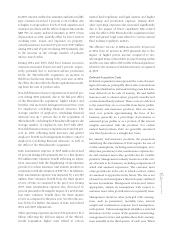American Express 2004 Annual Report Download - page 57
Download and view the complete annual report
Please find page 57 of the 2004 American Express annual report below. You can navigate through the pages in the report by either clicking on the pages listed below, or by using the keyword search tool below to find specific information within the annual report.
to maintain net short-term debt balances of approxi-
mately $14 billion over the period. TRS believes that its
funding plan is adequate to meet these requirements.
TRS believes that its existing sources of funding provide
sufficient depth and breadth to meet normal operating
needs. In addition, alternative liquidity sources are
available, mainly in the form of the liquidity portfolio,
securitizations of cardmember receivables and loans
and committed bank credit facilities, to provide uninter-
rupted funding over a twelve-month period should
access to unsecured debt sources become impaired.
Liquidity Portfolio
During the normal course of business, funding activi-
ties may raise more proceeds than are necessary for
immediate funding needs. These amounts are invested
principally in overnight, highly liquid instruments. In
addition, in the fourth quarter of 2003, the Company
began a program to develop a liquidity portfolio in
which proceeds raised from such borrowings are
invested in U.S. Treasury securities. At December 31,
2004, the Company held $4.0 billion of U.S. Treasury
notes under this program.
The invested amounts of the liquidity portfolio provide
back-up liquidity, primarily for the commercial paper
program at Credco, and also flexibility for other short-
term funding programs at Centurion Bank and FSB. U.S.
Treasury securities are the highest credit quality and
most liquid of investment instruments available. The
Company can easily sell these securities or enter into
sale/repurchase agreements to immediately raise cash
proceeds to meet liquidity needs.
Committed Bank Credit Facilities
The Company maintained committed bank credit facili-
ties with 54 large financial institutions totaling $13.8 bil-
lion (including $1.96 billion at the Parent Company and
the $2.3 billion Australian Credit Facility discussed
below) at December 31, 2004. As contemplated, in the
second quarter of 2004, Credco borrowed $1.47 billion
under these facilities as part of a change in local funding
strategy for business in Canada. Credco has the right to
borrow a maximum amount of $12.7 billion (including
amounts outstanding) under these facilities, with a com-
mensurate reduction in the amount available to the Par-
ent Company. These facilities expire as follows (billions):
2005, $3.8; 2006, $2.2; 2007, $1.0 and 2009, $6.3. The
remaining lines of $0.5 billion have no expiration date.
The availability of the credit lines is subject to the
Company’s compliance with certain financial cov-
enants, including the maintenance by the Company
of consolidated tangible net worth of at least $8.75
billion, the maintenance by Credco of a 1.25 ratio of
combined earnings and fixed charges to fixed charges,
and the compliance by Centurion Bank and FSB with
applicable regulatory capital adequacy guidelines. At
December 31, 2004, the Company’s consolidated tan-
gible net worth was approximately $13.0 billion, Cred-
co’s ratio of combined earnings and fixed charges to
fixed charges was 1.36 and Centurion Bank and FSB
each exceeded the Federal Deposit Insurance Corpora-
tion’s “well capitalized” regulatory capital adequacy
guidelines. See Note 23 to the Consolidated Financial
Statements for a discussion of the potential effect of the
proposed spin-off of AEFA on the $8.75 billion tangible
net worth covenant.
In the third quarter of 2004, Credco entered into a new
5-year multi-bank credit facility for Australian $3.25 bil-
lion (approximately U.S. $2.3 billion) and borrowed
Australian $2.7 billion (approximately U.S. $1.9 billion)
under this credit facility to provide an alternate funding
source for business in Australia. The availability of the
Australian credit facility is subject to Credco’s mainte-
nance of a 1.25 ratio of combined earnings and fixed
charges to fixed charges.
Committed bank credit facilities do not contain material
adverse change clauses, which may preclude borrow-
ing under the credit facilities. The facilities may not be
terminated should there be a change in the Company’s
credit rating.
Contingent Liquidity Planning
TRS has developed a contingent funding plan that
enables it to meet its daily funding obligations when
access to unsecured funds in the debt capital markets is
impaired or unavailable. This plan is designed to ensure
that the Company and all of its main operating entities
could continuously maintain normal business opera-
tions for at least a twelve-month period in which its
access to unsecured funds is interrupted. From time to
time, Credco, Centurion Bank or FSB may increase its
liquidity portfolio in order to pre-refund maturing debt
obligations when financial market conditions are favor-
able. These levels are monitored and adjusted when
necessary to maintain short-term liquidity needs in
response to seasonal or changing business conditions.
In addition, the Company maintains substantial flexibil-
ity to reduce its operating cash requirements, such as
through its share repurchase program, and the delay or
deferment of certain operating expenses.
The funding sources that would be relied upon depend
on the exact nature of such a hypothetical liquidity cri-
sis; nonetheless, TRS’ liquidity sources are designed
AXP
AR.04
55
Financial Review
























